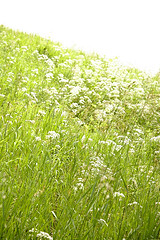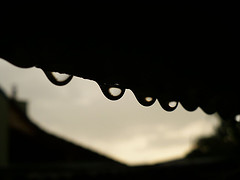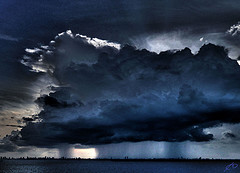Should You Expose For Shadows Or Highlights?
I guess the answer to this question can only come from the photographer taking the shot. Really, you should expose for whatever helps you capture your vision of the scene in front of you. I've seen great photos that were taken underexposed, overexposed, and perfectly exposed — but the photos were great because they captured the artist's intent.
It's generally accepted that digital photographers should expose for the highlights in order to keep things from getting blown out. It's generally a good rule of thumb because pure white pixels tend to be more distracting than pure black pixels — but there are always exceptions. I've also heard once or twice that film photographers should expose for the shadows because the film can be processed in such a way that the highlights can be somewhat revived — I have no idea if that's totally true, but maybe a film buff can set us straight in the comments.
Regardless, these are general rules and you're probably better off knowing the story behind the root issues than taking advice from a rule of thumb. The intent of this article is only to provide information that can be used to make decisions about exposure in harsh lighting conditions. So here we go…
WHY DO YOU HAVE TO CHOOSE BETWEEN THE TWO?
Film and digital sensors make a record of light intensity. Bright light is recorded at a high intensity, while dim light is recorded at low intensity. Film and sensors have a limited ability to record light, and they can only capture light between certain intensities. If there is not enough light to register, you end up with black. If there is too much light, you end up with white. These high and low thresholds make up what's called the dynamic range (definition by Jim Goldstein) of the medium.
WHAT DOES DYNAMIC RANGE HAVE TO DO WITH IT?
When you photograph a scene that contains light intensities beyond the dynamic range, you end up clipping one or both sides of the range. You can see when this happens by checking your image histogram for clipped values. This usually occurs in harsh lighting conditions such as bright sunlight. At this point, no matter what you do to your f-number, shutter speed, or medium sensitivity, you still have the same dynamic range. One option to deal with this issue is to use HDR techniques (which I won't get into here) so that the entire range can be captured. The other option is to shift your exposure and try to minimize the damage.
WHAT'S THE DIFFERENCE BETWEEN EXPOSURE METHODS?
Well, you actually have three buckets to choose from when it comes to shifting your exposure: preserve the highlights, preserve the shadows, or throw both out the window and expose for mid-tones. All three options will result in a different image, and each has it's positive and negative characteristics. As the artist, you have to decide what you want the photo to look like, and how to go about making that happen.
To assist with visualizing all this stuff about dynamic range, highlights, shadows, light intensity, clipping, HDR, etc. I'll use an analogy to bring it to something a little more tangible. Imagine that you're standing on the peak of a small mountain surrounded by beautiful scenery. You have your camera, but you only brought your fixed focal length lens. You want to capture a part of the scene before you, but when you look through the camera you realize that you can't get the whole scene in one shot — your viewing angle isn't wide enough! What to do? You can't move off the mountain peak because then it will be in the way of your scene, and you can't switch to a wider lens because you didn't bring your camera bag.
Keep this analogy in mind and I'll come back to it as I discuss exposure options. In the analogy, the scene represents the full range of light intensity you want to capture, the lens represents your film or sensor, the viewing angle of the lens represents the dynamic range of your film or sensor, and your aim represents exposure.
EXPOSING FOR THE SHADOWS
- What It Means
If you “expose for the shadows”, you're choosing to preserve the low light region of your exposure. When you look at the histogram, you won't see any clipping on the left side. Essentially, you're shifting the light toward the highlights, thus making a brighter image. - How You Do It
To shift your exposure for the shadows, you can use a slower shutter speed, decrease your f-number (aka increase your aperture size), and/or increase your medium sensitivity (aka ISO or film speed). - Positives
This method preserves the detail in the dark regions of the image, so you won't end up with pitch black pixels and you won't lose texture detail in the dark regions. - Negatives
While you maintain detail in the shadows, you also force less detail preservation in the highlights. You'll end up with pure white pixels that no amount of Photoshop can bring back to life. - The Analogy
Back to our beautiful mountain scene, you decided to point your camera to the left of center scene. You included the left-most edge of what you wanted to capture, but you had to leave out a chunk of the right edge.
EXPOSING FOR THE HIGHLIGHTS
- What It Means
If you “expose for the highlights”, you're choosing to preserve the high intensity light region of your exposure. Looking at the histogram shows that there is no clipping on the right side. You've shifted the light toward the shadows, thus making a darker image. - How You Do It
To shift your exposure for the highlights, you can use a faster shutter speed, increase your f-number, and/or decrease your medium sensitivity. - Positives
Opposite from the last example, this method preserves the detail in the bright regions of the image. You won't have any pure white pixels, and you'll retain texture detail. - Negatives
Keeping those puffy white clouds from blowing out has caused your shadows to be plummeted into darkness — pitch black. Just like with overblown highlights, you can't bring them back with Photoshop. - The Analogy
In the last example, you turned left. But in this example, you turned right. You decided to capture the right-most edge of the scene and let the left side get cropped out.
EXPOSING FOR THE MID-TONES
- What It Means
If you “expose for the mid-tones”, you're choosing to exclude the high and low intensity light from your image. The histogram will reveal that the left and right side are clipped. - How You Do It
The same methods apply from above to shutter speed, f-number, and ISO. You just shift up or down until you have a centered exposure. - Positives
The shadows and highlights won't be clipped as severely as in the previous two examples. - Negatives
The shadows and highlights are both clipped, and you lose information on both sides of the spectrum. The image will contain pure black and pure white pixels at the same time (just in different spots). - The Analogy
Rather than turning left or right, you decide to shoot right down the center of the scene. You lose a bit of scenery on both sides, but it's not as severe.
EXTENDING YOUR DYNAMIC RANGE
- What It Means
Just because you can't capture all the light values in one shot doesn't mean that you can't capture them. Taking multiple exposures by shooting for the highlights, shadows, and mid-tones will allow you to combine the information during post-processing via HDR imaging (High Dynamic Range). You effectively widen the dynamic range of the sensor or film by splitting it up into several shots. - How You Do It
Use the same methods from above to get all the exposures you need in order to include the entire light intensity range. Just remember to use your tripod. The best method for shifting exposure is accomplished by varying your shutter speed — a change in f-number will effect your depth of field, and a change in ISO value will effect your noise levels. - Positives
No clipping! You get the entire range of light. - Negatives
It takes a bit of post-processing to achieve really good HDR results. When poorly done, it looks worse than blown out highlights. Even when done well, the resulting photo typically has an unnatural look and feel to it — but maybe tha's what you're going for. - The Analogy
From your mountain peak, you decide that you want to capture the entire scene and you don't want to leave anything out. So take two or three overlapping shots and use software to stitch them together as a panorama.
GETTING CREATIVE WITH WHAT YOU HAVE
- What It Means
Rather than taking harsh lighting conditions as an impedance to your photography, use it to your advantage. Get creative. - How You Do It
Check out Andrew's articles on How to Take Great Photos at High Noon — he has some great tips. - Positives
It's fun and you get to enjoy yourself. - Negatives
You have to use your brain. - The Analogy
Get off your mountain peak and go take pictures of something else!
SO WHAT DOES IT ALL MEAN?
It means that you should have a basic understanding of how to control exposure and the effects of clipped histograms. Or maybe it means that you should have a battle plan for harsh lighting conditions. Or maybe it means that you should learn HDR techniques. Or maybe it means that you should learn to be more creative.
Or maybe it's just information… now go take some pictures.







Andrew Ferguson
August 20, 2007Intense article! I’ve been noticing a lot of debate lately on whether to underexpose or overexpose if a proper exposure is impossible. Personally, I’m in favour of underexposure but I’m aware that it does have it’s disadvantages.
Which do you prefer?
Brian Auer
August 20, 2007I typically try to underexpose if I have no choice, but I try to be mindful of the message I’m looking to convey. I have a couple overexposed shots that still need to be processed and prettied up, and the overexposure suits them very well. The main reason I typically try to underexpose is because I find blown out highlights to be much much more distracting than underexposed shadows.
The Dino
August 22, 2007Interesting, I usualy dont think about exposure. Now I should do something about it.
Brian Auer
August 22, 2007You’re darned right you should — you ought to participate in the overexposure project that’s running right now. Also keep your eyes peeled for some practical tips on controlling exposure in the next couple of days.
Chris Johnson
August 25, 2007This one’s simple. A camera with a 12 bit sensor is able to reproduce 4,096 (2 to the 12th power) levels of distinct tones in it’s images. The problem is that the tone’s aren’t divided equally between each f stop in the camera. The brightest stop contains half (2,048) of those levels and each stop under that is half again. So even by underexposing just one stop, you are fully wasting half of your cameras power. The solution is to expose the sensor as much as possible just to the point of clipping the highlights and adjust the file (hopefully you shoot RAW) in Photoshop later. Underexposing also introduces a lot of noise in the shadows. Hope this helps!